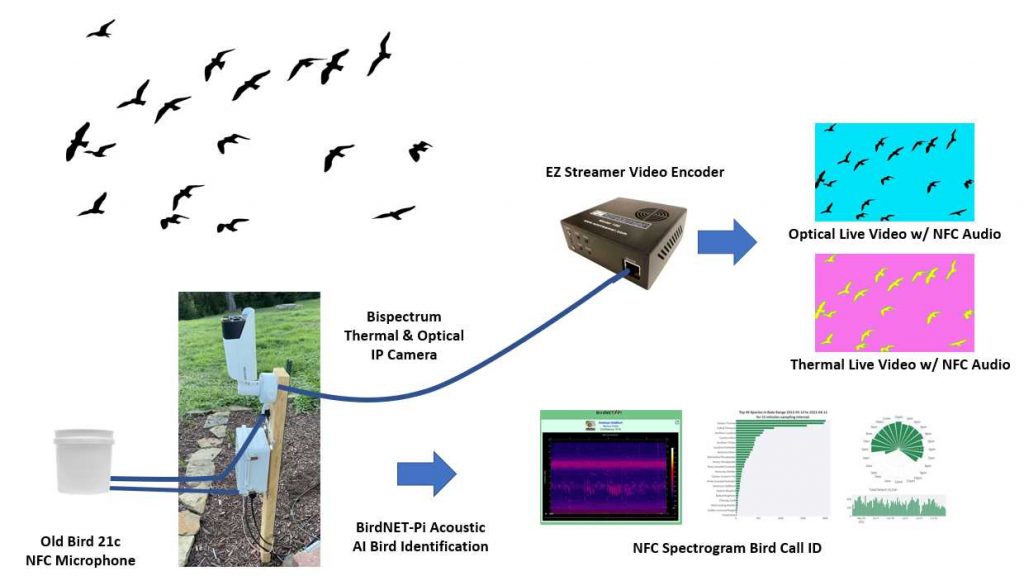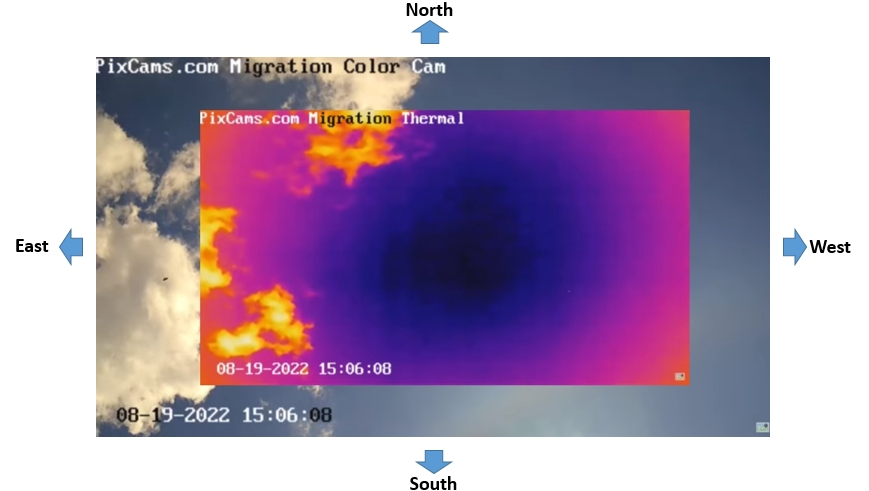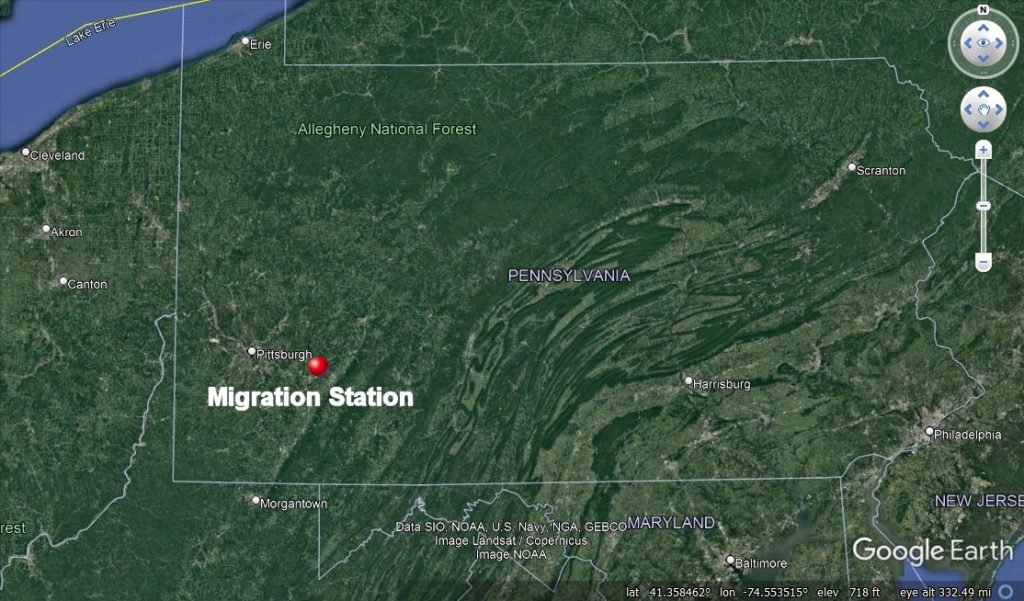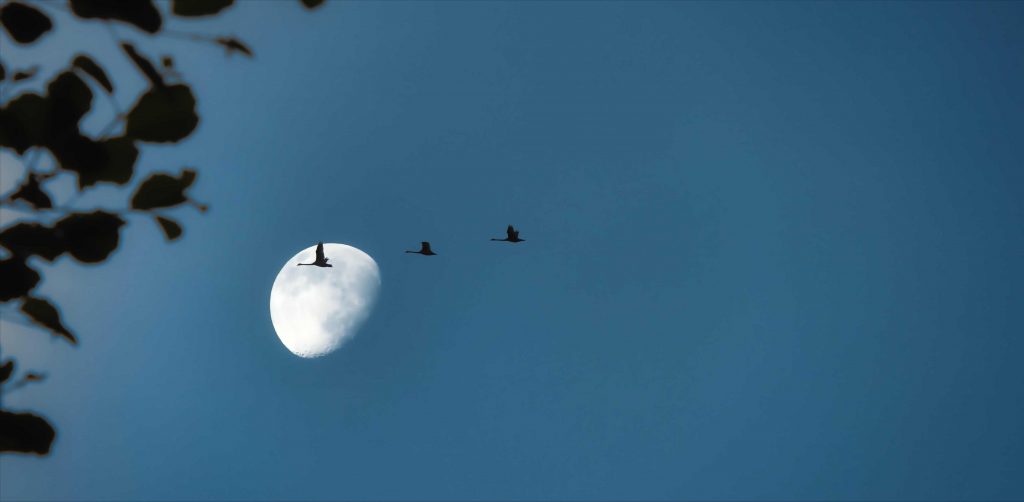Welcome to the PixCams Live Bird Migration Station
Introduction
The PixCams Live Bird Migration Station is a unique bird migration station that combines several types of technologies to study and watch the spring & fall bird migration in south western Pennsylvania. This migration station is located in Murrysville, PA and will run year round for collecting citizen science data. This station combines live streaming optical and thermal cameras, and a real-time bioacoustics for analyzing nocturnal flight calls (NFCs). Link for BirdCast PA Dashboard for Westmoreland County, PA daily migration data. For technical information click here for the PixCams Bird Migration Station Blog Post.
Note: The optical camera and thermal camera will automatically turn off from 10 AM – 4 PM EST daily to protect the thermal camera from direct sunlight.
Current Weather Conditions
Videos Captured with the Optical/Thermal Camera (YouTube Playlist)
.
How the System Works
The PixCams Bird Migration Station includes the following components:
- Hikvision Bispectrum Thermal & Optical IP Camera: Optical 1080P Resolution, Thermal 720P Resolution
- Old Bird 21c Nocturnal Flight Call Microphone
- BirdNET-Pi AI Acoustic Bird Call ID System
- EZ Streamer Video Encoder
The system first captures the audio call of the bird migrating at night with a specially designed microphone for this purpose, the Old Bird 21c microphone designed by Bill Evans.
Acoustic monitoring offers several advantages over other methods of monitoring populations namely because it allows researchers to identify species. Other techniques, such as radar, can identify numbers of birds but lack the species information found in night calls.
The Nocturnal Flight Call (NFC) acoustic signal is then analyzed the BirdNET real-time AI bird identification system. BirdNET converts the incoming audio data into Spectrograms that are analyzed through the BirdNET Neural Network for species identification. The BirdNET data is available to anyone in the above window or at this public domain: Migration BirdNET Station
The thermal camera is used to view large flocks of birds migrating at night. The thermal camera will pick up the heat signature of large flocks and the live video from the camera and audio from the NFC microphone is encoded into a live video stream for YouTube using our EZ Streamer video encoder.
Migration Station Diagram

Nocturnal Migration Useful Links
Online NFC field guide from Bill Evans and Michael O’Brien
http://oldbird.org/pubs/fcmb/pages/species.htm
Nocturnal Flight Calls Facebook group
https://www.facebook.com/groups/NocturnalFlightCalls
BirdCast bird migration forecasting service
https://birdcast.info/
BirdVox – Machine Listening for Bird Migration Monitoring
https://wp.nyu.edu/birdvox/
How well does the thermal camera work?
See the below example. We captured a video of a large bird migrating at 2:43 AM during the fall migration on 8/18/2022. This video was captured under very foggy weather conditions. See the Optical Video vs Thermal Video to see how well a thermal camera can pick up the heat signature of a bird through heavy fog flying at a high altitude.
Optical Video
Thermal Video
Camera direction, zoom, and location
Below are several images that show what direction the camera is facing, the zoom of the thermal camera relative to the optical camera, and the location of the PixCams Bird Migration Station.
The top of the camera image is facing north. This will give you an indication of the flight direction of the birds moving across the image. You will also notice that you see more area around the edges of the optical camera that you do not see in the thermal camera. This is because the thermal camera is zoomed in with respect to the optical camera. The graphic will demonstrate the field of view of the thermal camera compared to the optical camera. Lastly, the PixCams Bird Migration Station is located in Murrysville, PA as shown on the map.

Because the top of thermal imager is toward the north, and the camera is pointing upward, east is on the left side and west is on the right side of the display. Also, the field of view of the optical camera is larger than the thermal camera as shown above.

About the Night Migration
Nocturnal migration in the United States refers to the phenomenon where many species of birds and insects undertake long-distance journeys during the night. This migration typically occurs in the spring and fall, though it can vary depending on the species and their specific migration patterns.
In the spring, birds and insects migrate northward from their wintering grounds in the southern regions of the USA to breeding grounds in the northern states and Canada. This migration is driven by the availability of food and nesting sites as well as longer daylight hours. In the fall, many of these same species migrate southward to escape the colder temperatures and diminishing food sources as winter approaches.
The timing of nocturnal migration can vary depending on factors such as weather conditions, temperature, and daylight hours. Generally, nocturnal migration peaks during the hours of darkness, particularly during the late evening and early morning hours when the skies are clearer and predators are less active.
Researchers and birdwatchers often track and study this migration phenomenon using techniques such as radar, acoustic monitoring, and visual observations. These studies help scientists understand the routes, timing, and behavior of migratory species, which is crucial for conservation efforts and managing habitats to support these populations.
Estimates vary, but it’s generally believed that a significant proportion of birds engage in nocturnal migration. Some studies suggest that around 80% of land bird species migrate at night. This figure can vary depending on the region, the species being studied, and other factors.
Nocturnal migration is particularly common among songbirds, waterfowl, shorebirds, and raptors. These birds often migrate under the cover of darkness to avoid predators, take advantage of cooler temperatures, and navigate using celestial cues such as stars and the Earth’s magnetic field.
While many birds migrate at night, some species, especially larger birds of prey and waterfowl, may migrate during the day. Additionally, certain species may engage in a combination of diurnal (daytime) and nocturnal migration, depending on factors such as weather conditions and the availability of food and suitable habitats along their migration routes.
Methods to Monitor the Nocturnal Migration of Birds
Several modern methods are employed to monitor the nocturnal migration of birds. These techniques allow researchers to study the timing, routes, and behaviors of migrating birds. Some common methods include:
Radar Monitoring: Weather radar systems can detect the movement of birds through the atmosphere. Radar data can be analyzed to track the density, altitude, and direction of bird migration. Doppler radar, in particular, is useful for distinguishing between bird and weather-related movements.
Acoustic Monitoring: Recording devices can capture the sounds of migrating birds, particularly their flight calls. Automated acoustic monitoring stations are placed in strategic locations to record bird calls throughout the night. These recordings are then analyzed to identify species and estimate the intensity of migration.
Radio Tracking: Researchers attach small radio transmitters or GPS tracking devices to individual birds to monitor their movements during migration. While this method is more commonly used for studying diurnal migration, it can also provide insights into the behavior of some nocturnal migrants.
Visual Observations: Despite the limitations of observing birds at night, visual surveys are still conducted by researchers and volunteers using techniques such as moon-watching or spotlighting. These observations can provide valuable data on the timing and behavior of nocturnal migrants.
Light Detection and Ranging (LiDAR): LiDAR technology uses laser beams to create detailed three-dimensional maps of the landscape. LiDAR can be used to detect and track bird movements by analyzing the reflections of laser pulses off flying birds.
Satellite Tracking: While less common for studying nocturnal migration due to technical challenges, satellite tracking can provide valuable information on the long-distance movements of certain bird species, particularly those that migrate over large bodies of water.
These methods are often used in combination to provide a comprehensive understanding of nocturnal migration patterns. They help researchers identify important stopover sites, migration corridors, and potential threats to migrating bird populations, aiding in conservation efforts and the management of critical habitats.

